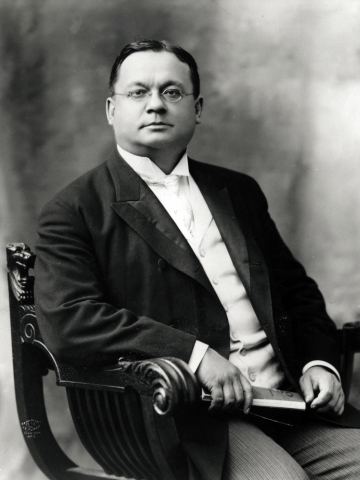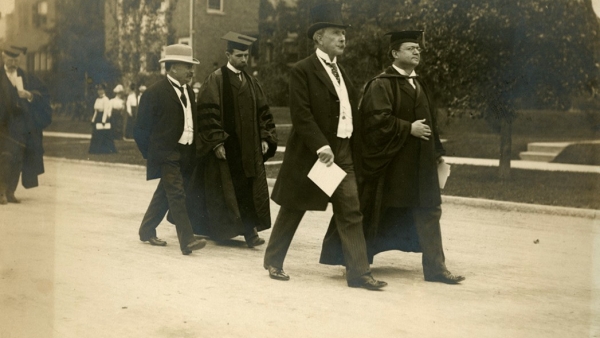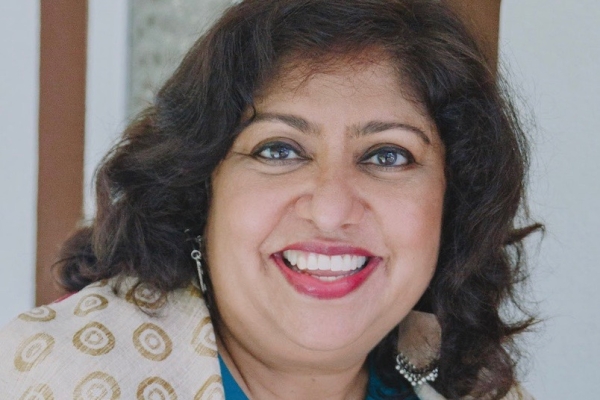Article |
A Brief History of the Graham School: President Harper’s Vision
Graham’s history dates back to the founding of the University. Learn more.

As one of the first schools of university extension in the United States, the history of the Graham School of Continuing Liberal and Professional Studies has combined liberal arts for adults with professional education since its beginnings in the 1890s, when the University of Chicago was founded.

In the fall of 1890, after he had been offered the position as president of the refounded University of Chicago, William Rainey Harper wrote to John D. Rockefeller, “I have a plan which is at the same time unique and comprehensive, which I am persuaded will revolutionize university study in this country.”
What was that plan?
Harper’s plan became the University’s first bulletin, which the Board of Trustees enacted on December 27, 1890: defining “The work of the University shall be arranged under three general divisions, viz., The University Proper, The University-Extension Work, The University Publication Work.”
For Harper, the “University Proper” was not just a college, but a graduate school, with an emphasis upon research and the advancement of knowledge. This was expressed in the University’s motto: Crescat Scientia, Vita Excolatur: let knowledge grow from more to more, and so life be enriched.
The third “division” became the University Press. But what was “The University-Extension Work”?
Harper had a revolutionary plan for his new university, but while his research ideal is reasonably well known, few know that the other part of Harper’s plan was for a large liberal arts extension program, to bring the new University of Chicago to the masses. The University Extension work is the Graham School of Continuing Liberal and Professional Studies.
The origins of adult education developed out of two major strands in the nineteenth century: the Lyceum movement and University Extension. The Lyceum movement in the United States started the 1820s, and soon developed into an informal lecture circuit. An outgrowth of this was the Chautauqua Institution in upstate New York, founded in 1874 as a summer educational center for Sunday school teachers. Soon after, dozens of similar “chautauquas” opened throughout the U.S., offering upwards of 6,000 courses of study a year. In 1883, William Rainey Harper, then a young seminary professor, began directing the Chautauqua Institution’s education program, later becoming the principal of Chautauqua’s College of Liberal Arts, a position he continued for a few years even after becoming president of the University of Chicago.
The second movement in adult education was University Extension, which started in England at Cambridge in 1873, growing out of workingmen’s institutes. Led by Cambridge Fellow James Stuart, the first lecture series focused on the sciences, later expanding to liberal arts disciplines. A year later, Richard Green Moulton, MA, started as one of Cambridge’s first itinerate lecturers. Oxford joined the movement in 1885, and soon Cambridge, London, and Oxford developed a coordinated program for lecture courses throughout the UK. This movement caught the attention of U Penn Provost William Pepper, who created the American Society for the Extension of University Teaching in 1890, inviting Richard Green Moulton for its first convention in November. Moulton gave the major address, urging an extension program in the United States and setting forth its vision: “The essence of university education is that it is education for adults; it is voluntary, it is unlimited in scope, unlimited in age; it applies to a man’s whole life.”
Harper met with Moulton in Philadelphia in December 1890, offering him the position as America’s first professor of university extension at UChicago.
Harper’s plan for Extension included five major elements: “regular courses of lectures,” in downtown Chicago, “evening courses for men and women whose daily occupation will not permit them to take advantage of the regular college and university courses,” correspondence courses (which he had pioneered a decade earlier), special courses “on the scientific study of the Bible in its original languages,” and library extension.
In May 1892, Harper set forth the full mission of the University Extension Division, as it was, in his words, “an organic part of the University.” Harper was careful, though, to distinguish it from the lecture circuit: “This work, while it must be in a good sense popular, must also be systematic in form and scientific in spirit, and to be such it must be done under the direction of a university, by men who have had scientific training.” Harper insisted upon quality, continuity, and rigor, seeing that Extension’s mission was to break down the barriers of social class and “give to a great constituency that which is their just right and due.”
University Extension at Chicago began in October 1892, when the University of Chicago itself began offering classes. Within a few years, classes were offered at fifty-four different extension centers (thirty-nine outside Chicago), at such places as Hull House and the Scoville Institute in Oak Park. In 1898, the University offered the first classes downtown in the Fine Arts building; many of the students were teachers, few of whom had college degrees. In 1904, the Extension Division offered its first practical training courses, of evening classes for bank and railroad employees. In 1911, UChicago’s school for teachers consolidated with the Extension Division, now called “University College,” which soon had an enrollment of around 500 students.
To Harper: “The university touches life, every phase of life, at every point.” And of course it “goes to those who cannot come to it,” namely, the adult student. “The university is of the people, and for the people.” That’s one of the key components of William Rainey Harper’s vision, which continues to be carried on in its Graham School of Continuing Liberal and Professional Studies.
To Harper: 'The university touches life, every phase of life, at every point.' And of course it 'goes to those who cannot come to it,' namely, the adult student. 'The university is of the people, and for the people.'
Harper’s vision for university extension is caught up in his vision for the university as a whole, perhaps best expressed in his address “The University and Democracy,” delivered in March 1899, at the Charter Day of the University of California.
It is this “democratic spirit” that sets the university apart. Distinguishing it from elementary and secondary schools, along with colleges, which trained boys and girls, the “university” is limited only to those institutions “in which adults are associated.” Its mission is “to guide the people in the decision of questions which from time to time confront them, and to furnish leaders in the different callings in whom the people may have full confidence; in which facilities are furnished and encouragement afforded to grapple with the great problems of life and thought, in the worlds of matter and of mind, with the sole purpose of discovering truth, whatever bearing that discovery may have upon other supposed truth.”


